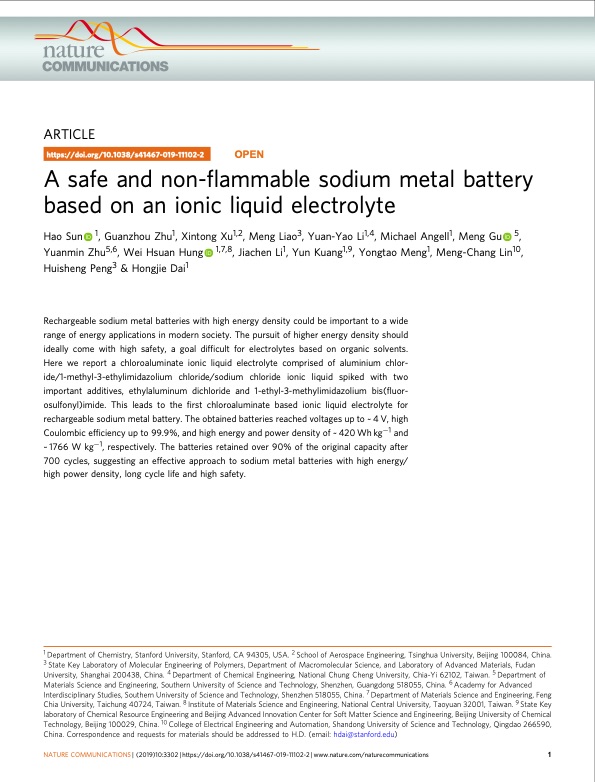
PDF Publication Title:
Text from PDF Page: 001
ARTICLE https://doi.org/10.1038/s41467-019-11102-2 OPEN A safe and non-flammable sodium metal battery based on an ionic liquid electrolyte Hao Sun 1, Guanzhou Zhu1, Xintong Xu1,2, Meng Liao3, Yuan-Yao Li1,4, Michael Angell1, Meng Gu 5, Yuanmin Zhu5,6, Wei Hsuan Hung 1,7,8, Jiachen Li1, Yun Kuang1,9, Yongtao Meng1, Meng-Chang Lin10, Huisheng Peng3 & Hongjie Dai1 Rechargeable sodium metal batteries with high energy density could be important to a wide range of energy applications in modern society. The pursuit of higher energy density should ideally come with high safety, a goal difficult for electrolytes based on organic solvents. Here we report a chloroaluminate ionic liquid electrolyte comprised of aluminium chlor- ide/1-methyl-3-ethylimidazolium chloride/sodium chloride ionic liquid spiked with two important additives, ethylaluminum dichloride and 1-ethyl-3-methylimidazolium bis(fluor- osulfonyl)imide. This leads to the first chloroaluminate based ionic liquid electrolyte for rechargeable sodium metal battery. The obtained batteries reached voltages up to ~ 4 V, high Coulombic efficiency up to 99.9%, and high energy and power density of ~ 420 Wh kg−1 and ~ 1766 W kg−1, respectively. The batteries retained over 90% of the original capacity after 700 cycles, suggesting an effective approach to sodium metal batteries with high energy/ high power density, long cycle life and high safety. 1 Department of Chemistry, Stanford University, Stanford, CA 94305, USA. 2 School of Aerospace Engineering, Tsinghua University, Beijing 100084, China. 3 State Key Laboratory of Molecular Engineering of Polymers, Department of Macromolecular Science, and Laboratory of Advanced Materials, Fudan University, Shanghai 200438, China. 4 Department of Chemical Engineering, National Chung Cheng University, Chia-Yi 62102, Taiwan. 5 Department of Materials Science and Engineering, Southern University of Science and Technology, Shenzhen, Guangdong 518055, China. 6 Academy for Advanced Interdisciplinary Studies, Southern University of Science and Technology, Shenzhen 518055, China. 7 Department of Materials Science and Engineering, Feng Chia University, Taichung 40724, Taiwan. 8 Institute of Materials Science and Engineering, National Central University, Taoyuan 32001, Taiwan. 9 State Key laboratory of Chemical Resource Engineering and Beijing Advanced Innovation Center for Soft Matter Science and Engineering, Beijing University of Chemical Technology, Beijing 100029, China. 10 College of Electrical Engineering and Automation, Shandong University of Science and Technology, Qingdao 266590, China. Correspondence and requests for materials should be addressed to H.D. (email: hdai@stanford.edu) NATURE COMMUNICATIONS | (2019)10:3302 | https://doi.org/10.1038/s41467-019-11102-2 | www.nature.com/naturecommunications 1 1234567890():,;PDF Image | sodium metal battery based on an ionic liquid electrolyte

PDF Search Title:
sodium metal battery based on an ionic liquid electrolyteOriginal File Name Searched:
s41467-019-11102-2.pdfDIY PDF Search: Google It | Yahoo | Bing
Product and Development Focus for Salgenx
Redox Flow Battery Technology: With the advent of the new USA tax credits for producing and selling batteries ($35/kW) we are focussing on a simple flow battery using shipping containers as the modular electrolyte storage units with tax credits up to $140,000 per system. Our main focus is on the salt battery. This battery can be used for both thermal and electrical storage applications. We call it the Cogeneration Battery or Cogen Battery. One project is converting salt (brine) based water conditioners to simultaneously produce power. In addition, there are many opportunities to extract Lithium from brine (salt lakes, groundwater, and producer water).Salt water or brine are huge sources for lithium. Most of the worlds lithium is acquired from a brine source. It's even in seawater in a low concentration. Brine is also a byproduct of huge powerplants, which can now use that as an electrolyte and a huge flow battery (which allows storage at the source).We welcome any business and equipment inquiries, as well as licensing our flow battery manufacturing.| CONTACT TEL: 608-238-6001 Email: greg@salgenx.com | RSS | AMP |